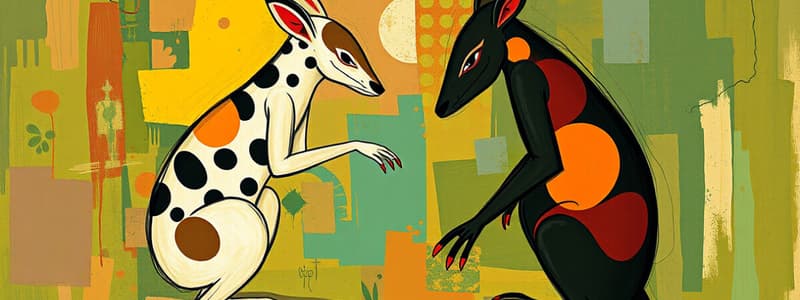Podcast
Questions and Answers
What is the main conflict in 'Rikki-tikki-tavi'?
What is the main conflict in 'Rikki-tikki-tavi'?
Rikki-tikki-tavi must keep Teddy and his family safe, and they are threatened by cobras living in the garden.
What is internal conflict?
What is internal conflict?
man vs. self
What is an example of an internal conflict (man vs. self) in the story?
What is an example of an internal conflict (man vs. self) in the story?
Chuchundra is too afraid to run into the middle of a room.
According to the narrator, what is the typical relationship between a mongoose and a cobra?
According to the narrator, what is the typical relationship between a mongoose and a cobra?
Which of the following events is part of the falling action in the story?
Which of the following events is part of the falling action in the story?
What literary device is represented by the statement 'Who is Nag?' said he. 'I am Nag. The great god Brahm put his mark upon all our people when the first cobra spread his hood to keep the sun off Brahm as he slept. Look, and be afraid!'?
What literary device is represented by the statement 'Who is Nag?' said he. 'I am Nag. The great god Brahm put his mark upon all our people when the first cobra spread his hood to keep the sun off Brahm as he slept. Look, and be afraid!'?
Which concept is used as a metaphor in both the story and in 'Darzee's Chaunt'?
Which concept is used as a metaphor in both the story and in 'Darzee's Chaunt'?
Which character in the story is motivated by revenge?
Which character in the story is motivated by revenge?
Which excerpt below best exemplifies the motivation of Teddy's parents in the story?
Which excerpt below best exemplifies the motivation of Teddy's parents in the story?
Who are the antagonists in 'Rikki-tikki-tavi'?
Who are the antagonists in 'Rikki-tikki-tavi'?
What is a simile?
What is a simile?
What is a metaphor?
What is a metaphor?
What is personification?
What is personification?
What is an example of man vs. nature in the story?
What is an example of man vs. nature in the story?
What is an example of man vs. society?
What is an example of man vs. society?
What is an example of man vs. man in the story?
What is an example of man vs. man in the story?
What is the exposition in the story?
What is the exposition in the story?
What is exposition?
What is exposition?
What is rising action?
What is rising action?
What is climax?
What is climax?
Flashcards are hidden until you start studying
Study Notes
Main Conflict
- Rikki-tikki-tavi’s main objective is to safeguard Teddy and his family from cobras in their garden.
Internal Conflict
- Internal conflict is defined as a struggle within a character, exemplified by Chuchundra's fear to enter the middle of a room.
Relationship Between Characters
- The narrative portrays a mongoose and a cobra as natural enemies, emphasizing their instinctual opposition.
Falling Action
- An event depicting falling action is when red ants descend into a hole, showcasing their role in the ecosystem.
Allusion
- Nag refers to an allusion about Brahm, indicating cultural storytelling and ancestral beliefs, enriching the narrative's depth.
Death as a Metaphor
- The concept of death is woven into both the story's main events and Darzee's song, highlighting the prevailing theme.
Motivated by Revenge
- Nagaina's character is driven by vengeance, adding complexity and emotional stakes to the conflict.
Teddy’s Parents’ Motivation
- Teddy's father believes Rikki-tikki-tavi provides better protection than a bloodhound, reflecting the family's trust in the mongoose.
Antagonists
- Nag and Nagaina serve as the primary antagonists, representing the threats that Rikki-tikki-tavi must confront.
Literary Devices
- Simile is defined as a direct comparison using "like" or "as"; metaphor compares two different entities as if they are the same.
- Personification attributes human characteristics to non-human entities, enhancing emotional engagement.
Man vs. Nature
- An illustration of man vs. nature occurs when Rikki is washed out of his original burrow by a flood, showcasing environmental conflicts.
Man vs. Society
- The oppressive rule of the snakes over other garden animals exemplifies a societal conflict, impacting the lives of all creatures living there.
Man vs. Man
- A clear example of man vs. man is Rikki's battles against Nag and Nagaina, marked by direct confrontation.
Exposition
- The story's exposition introduces Teddy, his family, Rikki-tikki-tavi, and other garden animals, establishing the setting as a bungalow in India during the past.
Definition of Exposition
- Exposition encompasses the initial presentation of characters, background, and setting, laying the groundwork for the narrative.
Rising Action
- Rising action includes the series of events that build momentum leading to the story's climax.
Climax
- The climax signifies the pivotal turning point in the story, where the primary conflict reaches its peak.
Studying That Suits You
Use AI to generate personalized quizzes and flashcards to suit your learning preferences.




